The global industrial chemical packaging market is valued at USD 58,342 million in 2025 and is set to reach USD 97,783.4 million by 2035, growing at a CAGR of 5.3%. The market stands at the forefront of a transformative decade that promises to redefine hazardous material containment infrastructure and chemical storage excellence across petrochemical, agrochemical, specialty chemical, and industrial manufacturing sectors. The market's journey from USD 58,342 million in 2025 to USD 97,783.4 million by 2035 represents substantial growth, demonstrating the accelerating adoption of advanced containment solutions and sophisticated safety-engineered systems across corrosive liquids, reactive powders, volatile solvents, and specialized chemical compound applications.
The first half of the decade (2025-2030) will witness the market climbing from USD 58,342 million to approximately USD 74,825 million, adding USD 16,483 million in value, which constitutes 42% of the total forecast growth period. This phase will be characterized by the rapid adoption of high-barrier containment systems, driven by increasing demand for regulatory compliance solutions and enhanced material compatibility worldwide. Superior chemical resistance capabilities and leak-prevention features will become standard expectations rather than premium options.
The latter half (2030-2035) will witness sustained growth from USD 74,825 million to USD 97,783.4 million, representing an addition of USD 23,031 million or 58% of the decade's expansion. This period will be defined by mass market penetration of specialized intermediate bulk containers, integration with comprehensive supply chain tracking platforms, and seamless compatibility with existing chemical production and distribution infrastructure. The market trajectory signals fundamental shifts in how chemical manufacturers and logistics providers approach hazardous material packaging solutions, with participants positioned to benefit from sustained demand across multiple industrial segments.
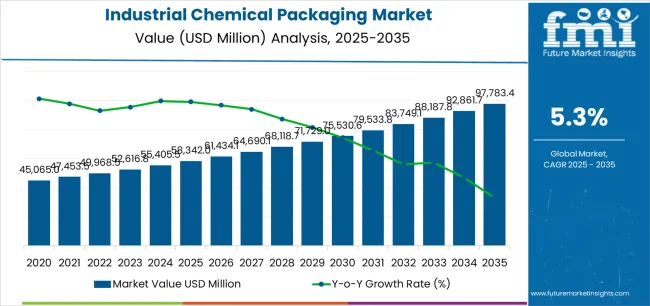
The industrial chemical packaging market demonstrates distinct growth phases with varying market characteristics and competitive dynamics. Between 2025 and 2030, the market progresses through its regulatory compliance adoption phase, expanding from USD 58,342 million to USD 74,825 million with steady annual increments averaging 5.1% growth. This period showcases the transition from standard industrial containers to advanced systems with enhanced chemical resistance and integrated safety features becoming mainstream requirements.
The 2025-2030 phase adds USD 16,483 million to market value, representing 42% of total decade expansion. Market maturation factors include standardization of UN-certified packaging protocols, declining component costs for specialty barrier materials, and increasing manufacturer awareness of chemical compatibility requirements reaching 80-85% effectiveness in hazardous material applications. Competitive landscape evolution during this period features established manufacturers like Greif Inc. and Mauser Packaging Solutions expanding their chemical packaging portfolios while new entrants focus on specialized composite containers and enhanced sealing technology.
Based on Future Market Insights (FMI)’s verified data on biopolymer, flexible, and rigid packaging adoption, from 2030 to 2035, market dynamics shift toward advanced material innovation and multi-modal transport deployment, with growth accelerating from USD 74,825 million to USD 97,783.4 million, adding USD 23,031 million or 58% of total expansion. This phase transition logic centers on universal chemical packaging systems, integration with automated filling equipment, and deployment across diverse hazardous material scenarios, becoming standard rather than specialized containment formats. The competitive environment matures with focus shifting from basic barrier quality to comprehensive supply chain integration and compatibility with international shipping regulations.
| Metric | Value |
|---|---|
| Market Value (2025) | USD 58,342 million |
| Market Forecast (2035) | USD 97,783.4 million |
| Growth Rate | 5.30% CAGR |
| Leading Technology | Plastic |
| Primary Application | Bulk Liquid Segment |
The market demonstrates strong fundamentals with plastic systems capturing a dominant share through superior chemical resistance and reliable containment capabilities. Bulk liquid applications drive primary demand, supported by increasing petrochemical production requirements and industrial solvent distribution solutions. Geographic expansion remains concentrated in Asia-Pacific markets with expanding chemical manufacturing infrastructure, while established regions show steady adoption rates driven by regulatory compliance and safety enhancement programs.
Market expansion rests on three fundamental shifts driving adoption across chemical manufacturing and distribution sectors. 1. Regulatory compliance creates compelling advantages through industrial chemical packaging systems that provide certified hazardous material containment with mandatory safety features, enabling manufacturers to meet transportation regulations while maintaining operational efficiency and justifying premium pricing over non-certified alternatives. 2. Chemical production acceleration occurs as petrochemical complexes worldwide seek reliable storage systems that deliver material compatibility directly to distribution networks, enabling supply chain continuity that aligns with manufacturing protocols and worker safety requirements. 3. Industrial expansion drives adoption from specialty chemical manufacturers requiring robust packaging solutions that maximize containment integrity while maintaining chemical stability during storage and transportation operations.
Growth faces headwinds from material compatibility challenges that vary across chemical segments regarding container construction and liner specifications, potentially limiting deployment flexibility in highly reactive or corrosive chemical categories. Transportation regulation complexity also persists regarding multi-modal shipping requirements and certification standards that may increase operational complexity in markets with demanding hazardous material protocols.
The industrial chemical packaging market represents a compelling intersection of hazardous material containment innovation, regulatory compliance management, and supply chain safety optimization. With robust growth projected from USD 58,342 million in 2025 to USD 97,783.4 million by 2035 at a 5.30% CAGR, this market is driven by increasing chemical production volumes, stringent transportation regulations, and industrial demand for certified containment formats.
The market's expansion reflects a fundamental shift in how chemical manufacturers and logistics operators approach hazardous material packaging infrastructure. Strong growth opportunities exist across diverse applications, from petrochemical operations requiring corrosive liquid containment to agrochemical facilities demanding powder formulation protection. Geographic expansion is particularly pronounced in Asia-Pacific markets, led by China (6.8% CAGR) and India (6.5% CAGR), while established markets in North America and Europe drive innovation and specialized segment development.
The dominance of plastic systems and bulk liquid applications underscores the importance of proven chemical resistance and regulatory certification in driving adoption. Material compatibility and transportation compliance remain key challenges, creating opportunities for companies that can deliver reliable performance while maintaining operational safety.
Primary Classification: The market segments by material type into plastic, metal, composite, and fiber categories, representing the evolution from basic industrial containers to advanced engineered substrates for comprehensive chemical containment operations.
Secondary Breakdown: Application segmentation divides the market into bulk liquid, powder & granular, specialty chemical, agrochemical, petrochemical, and others sectors, reflecting distinct requirements for chemical resistance, pressure tolerance, and regulatory certification.
Regional Classification: Geographic distribution covers North America, Europe, Asia Pacific, Latin America, and the Middle East & Africa, with developed markets leading certification standards while emerging economies show accelerating growth patterns driven by chemical manufacturing expansion programs.
The segmentation structure reveals technology progression from standard industrial drums toward integrated composite platforms with enhanced barrier and safety capabilities, while application diversity spans from petrochemical operations to specialty chemical facilities requiring precise material compatibility and leak-prevention solutions.
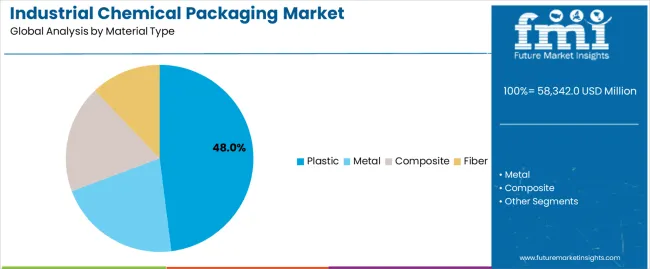
Plastic segment is estimated to account for 48% of the industrial chemical packaging market share in 2025. The segment's leading position stems from its fundamental role as a critical component in liquid chemical containment applications and its extensive use across multiple petrochemical and specialty chemical sectors. Plastic's dominance is attributed to its superior chemical resistance, including corrosive liquid compatibility, impact protection, and cost-effective manufacturing that make it indispensable for industrial chemical storage operations.
Market Position: Plastic systems command the leading position in the industrial chemical packaging market through advanced polymer technologies, including comprehensive material compatibility options, processing versatility, and reliable containment performance that enable manufacturers to deploy certified solutions across diverse chemical environments.
Value Drivers: The segment benefits from producer preference for proven engineered materials that provide exceptional protection without requiring expensive metal fabrication. Cost-effective production processes enable deployment in bulk liquid packaging, agrochemical distribution, and industrial solvent applications where chemical resistance and weight efficiency represent critical operational requirements.
Competitive Advantages: Plastic systems differentiate through excellent corrosion resistance, proven impact durability, and compatibility with automated filling equipment that enhance chemical protection while maintaining economical operational profiles suitable for diverse industrial applications.
Key market characteristics:
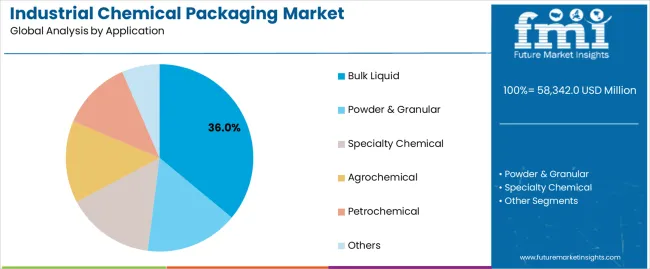
Bulk liquid segment is projected to hold 36% of the industrial chemical packaging market share in 2025. The segment's market leadership is driven by the extensive use of industrial chemical packaging in petrochemical solvents, industrial acids, liquid fertilizers, and cleaning compounds, where packaging serves as both a protective barrier and transportation containment tool. The chemical industry's consistent investment in liquid handling infrastructure supports the segment's dominant position.
Market Context: Bulk liquid applications dominate the market due to widespread adoption of large-volume containers and increasing focus on supply chain efficiency, transportation cost optimization, and hazardous material handling applications that enhance operational effectiveness while maintaining product integrity.
Appeal Factors: Chemical manufacturers prioritize containment reliability, regulatory certification, and integration with filling systems that enable coordinated deployment across multiple distribution channels. The segment benefits from substantial transportation requirements and safety standards that emphasize reliable packaging for industrial and commercial applications.
Growth Drivers: Petrochemical expansion programs incorporate industrial chemical packaging as standard format for solvent distribution and intermediate storage. At the same time, chemical industry initiatives are increasing demand for UN-certified systems that comply with transportation regulations and enhance logistics efficiency.
Market Challenges: Container size limitations and handling equipment requirements may limit deployment flexibility in small-batch chemical production or laboratory-scale operations.
Application dynamics include:
Growth Accelerators: Chemical production expansion drives primary adoption as industrial chemical packaging systems provide exceptional containment capabilities that enable hazardous material transport without environmental contamination, supporting regulatory compliance and worker safety that require certified storage formats. Petrochemical infrastructure accelerates market growth as refineries and chemical complexes seek cost-effective packaging solutions that maintain material integrity during distribution while enhancing logistics efficiency through standardized container systems. Industrial manufacturing increases worldwide, creating sustained demand for chemical-resistant packaging systems that complement production operations and provide competitive advantages in supply chain management environments.
Growth Inhibitors: Material compatibility challenges vary across chemical segments regarding polymer selection and liner construction requirements, which may limit market penetration and profit margins in highly corrosive categories with demanding resistance specifications. Certification complexity persists regarding UN performance testing and hazardous material classification that may increase lead times in custom applications with specialized containment standards. Market fragmentation across multiple container formats and capacity specifications creates interoperability concerns between different filling equipment and existing logistics infrastructure.
Market Evolution Patterns: Adoption accelerates in petrochemical and specialty chemical sectors where regulatory compliance justifies packaging investments, with geographic concentration in Asia-Pacific markets transitioning toward mainstream adoption in emerging manufacturing hubs driven by chemical production expansion and export requirements. Technology development focuses on enhanced composite materials, improved pressure resistance, and integration with automated logistics systems that optimize supply chain visibility and inventory management. The market could face disruption if alternative containment formats or material innovations significantly challenge traditional packaging advantages in chemical distribution applications.
The industrial chemical packaging market demonstrates varied regional dynamics with Growth Leaders including China (6.8% CAGR) and India (6.5% CAGR) driving expansion through chemical manufacturing growth and petrochemical complex development. Steady Performers encompass the USA (5.9% CAGR), Germany (5.1% CAGR), and Japan (4.8% CAGR), benefiting from established chemical sectors and specialty packaging adoption.
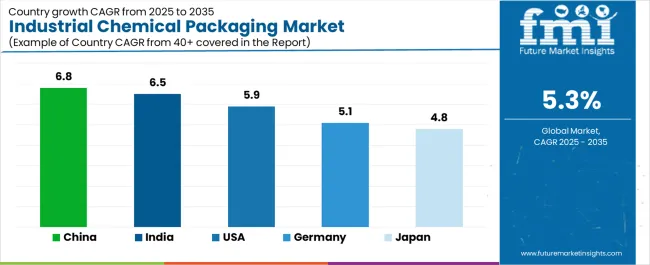
| Country | CAGR (2025-2035) |
|---|---|
| China | 6.8% |
| India | 6.5% |
| USA | 5.9% |
| Germany | 5.1% |
| Japan | 4.8% |
Regional synthesis reveals Asia-Pacific markets leading growth through petrochemical expansion and agrochemical production development, while European countries maintain steady expansion supported by specialty chemical innovation and circular economy packaging requirements. North American markets show strong growth driven by chemical manufacturing modernization and regulatory compliance programs.
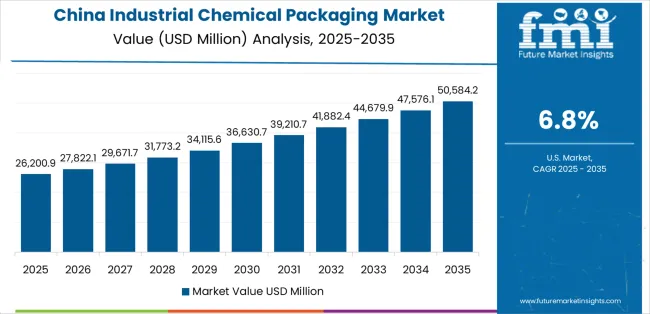
China establishes regional leadership through explosive petrochemical capacity expansion and comprehensive chemical manufacturing development, integrating advanced industrial chemical packaging systems as standard components in liquid solvent and bulk chemical applications. The country's 6.8% CAGR through 2035 reflects government initiatives promoting domestic chemical production and industrial self-sufficiency that mandate the use of certified containment systems in hazardous material operations. Growth concentrates in major chemical hubs, including Shandong, Jiangsu, and Zhejiang provinces, where petrochemical complexes showcase integrated packaging systems that appeal to domestic manufacturers seeking efficient distribution formats and international safety standards.
Chinese manufacturers are developing innovative chemical packaging solutions that combine local production advantages with international certification specifications, including UN-approved containers and advanced composite materials.
Strategic Market Indicators:
The Indian market emphasizes agrochemical and specialty chemical applications, including rapid manufacturing capacity development and comprehensive export infrastructure growth that increasingly incorporates industrial chemical packaging for liquid fertilizer distribution and pesticide formulation applications. The country is projected to show a 6.5% CAGR through 2035, driven by massive chemical production expansion under manufacturing initiatives and commercial demand for affordable, certified packaging systems. Indian chemical facilities prioritize cost-effectiveness with industrial packaging delivering reliable containment through economical material usage and efficient production capabilities.
Technology deployment channels include major petrochemical producers, agrochemical manufacturers, and chemical distribution facilities that support high-volume operations for domestic and export applications.
Performance Metrics:
The USA market emphasizes advanced chemical packaging features, including innovative composite technologies and integration with comprehensive supply chain tracking platforms that manage hazardous material transport, regulatory documentation, and inventory management applications through unified containment systems. The country is projected to show a 5.9% CAGR through 2035, driven by specialty chemical expansion under manufacturing programs and commercial demand for reliable, certified packaging systems. American chemical companies prioritize worker safety with industrial packaging delivering robust containment through impact-resistant construction and integrated safety features.
Technology deployment channels include major chemical producers, logistics operators, and specialty chemical programs that support custom development for hazardous material operations.
Performance Metrics:
In Frankfurt, Munich, and Hamburg, German chemical companies and specialty manufacturers are implementing advanced industrial chemical packaging systems to enhance containment reliability capabilities and support regulatory compliance that aligns with environmental protocols and safety standards. The German market demonstrates sustained growth with a 5.1% CAGR through 2035, driven by chemical innovation programs and specialty sector investments that emphasize certified packaging systems for hazardous material and pharmaceutical intermediate applications. German chemical facilities are prioritizing packaging systems that provide exceptional barrier performance while maintaining compliance with REACH regulations and minimizing environmental impact, particularly important in specialty chemical and electronic-grade material operations.
Market expansion benefits from environmental protection programs that mandate certified containment in chemical transportation specifications, creating sustained demand across Germany's chemical and pharmaceutical sectors, where material compatibility and safety features represent critical requirements.
Strategic Market Indicators:
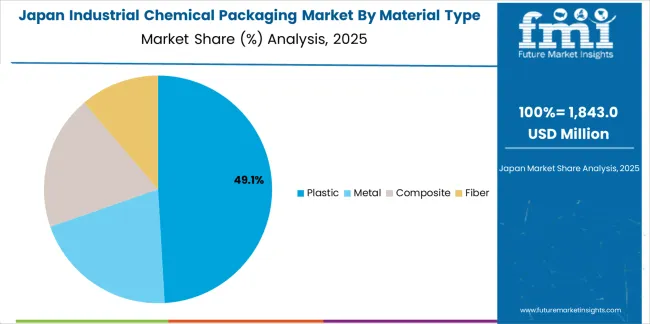
Japan's sophisticated chemical market demonstrates meticulous packaging deployment, growing at 4.8% CAGR, with documented operational excellence in specialty chemical containment and high-purity material applications through integration with existing logistics systems and quality assurance infrastructure. The country leverages engineering expertise in precision manufacturing and material science to maintain market leadership. Chemical centers, including Tokyo, Osaka, and Yokohama, showcase advanced installations where industrial packaging systems integrate with comprehensive supply chain platforms and inventory management systems to optimize material handling and worker safety.
Japanese chemical producers prioritize packaging precision and barrier reliability in container development, creating demand for flawless systems with advanced features, including hermetic sealing and integration with automated filling protocols. The market benefits from established chemical infrastructure and willingness to invest in specialized packaging technologies that provide superior material protection and regulatory compliance.
Market Intelligence Brief:
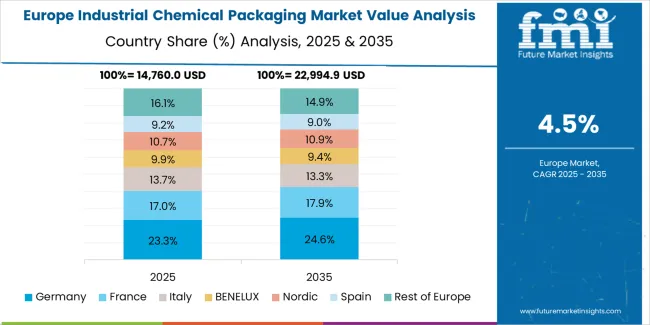
The industrial chemical packaging market in Europe is projected to grow from USD 16,824 million in 2025 to USD 26,947 million by 2035, registering a CAGR of 4.8% over the forecast period. Germany is expected to maintain its leadership position with a 41.5% market share in 2025, declining slightly to 40.8% by 2035, supported by its chemical manufacturing excellence and major production centers, including North Rhine-Westphalia and Bavaria.
France follows with a 19.8% share in 2025, projected to reach 20.3% by 2035, driven by comprehensive petrochemical infrastructure and specialty chemical initiatives. The United Kingdom holds a 13.7% share in 2025, expected to maintain 14.2% by 2035 through established chemical sectors and logistics modernization adoption. Italy commands a 10.4% share, while Spain accounts for 8.1% in 2025. The Rest of Europe region is anticipated to gain momentum, expanding its collective share from 6.5% to 7.1% by 2035, attributed to increasing chemical production in Eastern European countries and emerging Nordic specialty chemical facilities implementing certified containment programs.
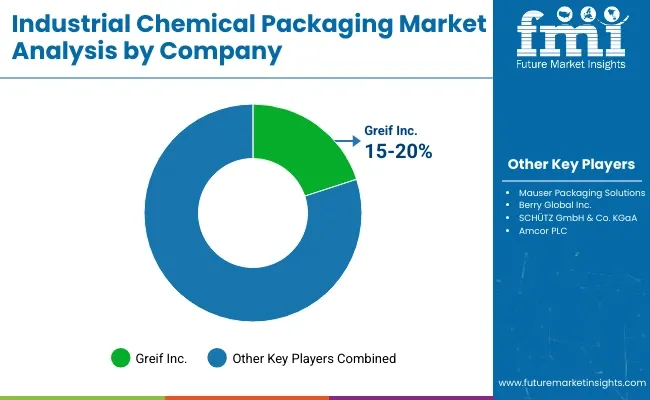
The industrial chemical packaging market operates with moderate concentration, featuring approximately 25-35 participants, where leading companies control roughly 42-48% of the global market share through established chemical industry relationships and comprehensive container certification capabilities. Competition emphasizes chemical resistance performance, regulatory compliance, and material compatibility rather than price-based rivalry.
Market leaders encompass Greif Inc., Mauser Packaging Solutions, and Berry Global Inc., which maintain competitive advantages through extensive manufacturing expertise, global distribution networks, and comprehensive UN certification capabilities that create customer loyalty and support technical specifications. These companies leverage decades of industrial packaging experience and ongoing material development investments to develop advanced chemical containers with exceptional containment and safety features.
Specialty challengers include Sealed Air Corporation, Sonoco Products Company, and Time Technoplast Ltd., which compete through specialized chemical packaging focus and innovative composite solutions that appeal to petrochemical manufacturers seeking cost-effective containment formats and flexible capacity options. These companies differentiate through material science emphasis and specialized hazardous material application focus.
Market dynamics favor participants that combine reliable chemical resistance with advanced certification support, including regulatory documentation and validation testing capabilities. Competitive pressure intensifies as traditional industrial packaging manufacturers expand into chemical-grade systems. At the same time, specialized composite container companies challenge established players through innovative barrier solutions and cost-effective production targeting emerging petrochemical segments.
| Item | Value |
|---|---|
| Quantitative Units | USD 58,342 million |
| Material Type | Plastic, Metal, Composite, Fiber |
| Application | Bulk Liquid, Powder & Granular, Specialty Chemical, Agrochemical, Petrochemical, Others |
| Regions Covered | North America, Europe, Asia Pacific, Latin America, Middle East & Africa |
| Countries Covered | USA, Germany, Japan, China, India, and 25+ additional countries |
| Key Companies Profiled | Greif Inc., Mauser Packaging Solutions, Berry Global Inc., Sealed Air Corporation, Sonoco Products Company, Time Technoplast Ltd. |
| Additional Attributes | Dollar sales by material type and application categories, regional adoption trends across Asia Pacific, North America, and Europe, competitive landscape with industrial packaging manufacturers and chemical logistics providers, producer preferences for chemical resistance and certification compliance, integration with automated filling equipment and supply chain systems, innovations in composite materials and barrier technology, and development of specialized containment solutions with enhanced safety and regulatory capabilities |
The global industrial chemical packaging market is estimated to be valued at USD 58,342.0 million in 2025.
The market size for the industrial chemical packaging market is projected to reach USD 97,783.4 million by 2035.
The industrial chemical packaging market is expected to grow at a 5.3% CAGR between 2025 and 2035.
The key product types in industrial chemical packaging market are plastic, metal, composite and fiber.
In terms of application, bulk liquid segment to command 36.0% share in the industrial chemical packaging market in 2025.






Full Research Suite comprises of:
Market outlook & trends analysis
Interviews & case studies
Strategic recommendations
Vendor profiles & capabilities analysis
5-year forecasts
8 regions and 60+ country-level data splits
Market segment data splits
12 months of continuous data updates
DELIVERED AS:
PDF EXCEL ONLINE
Market Positioning & Share in Industrial Chemical Packaging
Industrial Wired Routers Market Size and Share Forecast Outlook 2025 to 2035
Industrial Robot Controller Market Size and Share Forecast Outlook 2025 to 2035
Industrial Evaporative Condensers Market Size and Share Forecast Outlook 2025 to 2035
Industrial Energy Management System Market Size and Share Forecast Outlook 2025 to 2035
Industrial Insulation Market Size and Share Forecast Outlook 2025 to 2035
Industrial Safety Gloves Market Size and Share Forecast Outlook 2025 to 2035
Industrial Cleaner Market Size and Share Forecast Outlook 2025 to 2035
Industrial Dust Treatment System Market Size and Share Forecast Outlook 2025 to 2035
Industrial Vertical Washing Tower Market Size and Share Forecast Outlook 2025 to 2035
Industrial Pepper Market Size and Share Forecast Outlook 2025 to 2035
Industrial Absorbent Market Forecast and Outlook 2025 to 2035
Industrial Furnace Industry Analysis in Europe Forecast and Outlook 2025 to 2035
Industrial Denox System Market Size and Share Forecast Outlook 2025 to 2035
Industrial Electronic Pressure Switch Market Size and Share Forecast Outlook 2025 to 2035
Industrial WiFi Module Market Size and Share Forecast Outlook 2025 to 2035
Industrial Security System Market Forecast Outlook 2025 to 2035
Industrial Film Market Forecast Outlook 2025 to 2035
Industrial Floor Mat Market Forecast Outlook 2025 to 2035
Industrial Process Water Coolers Market Forecast and Outlook 2025 to 2035

Thank you!
You will receive an email from our Business Development Manager. Please be sure to check your SPAM/JUNK folder too.
Chat With
MaRIA